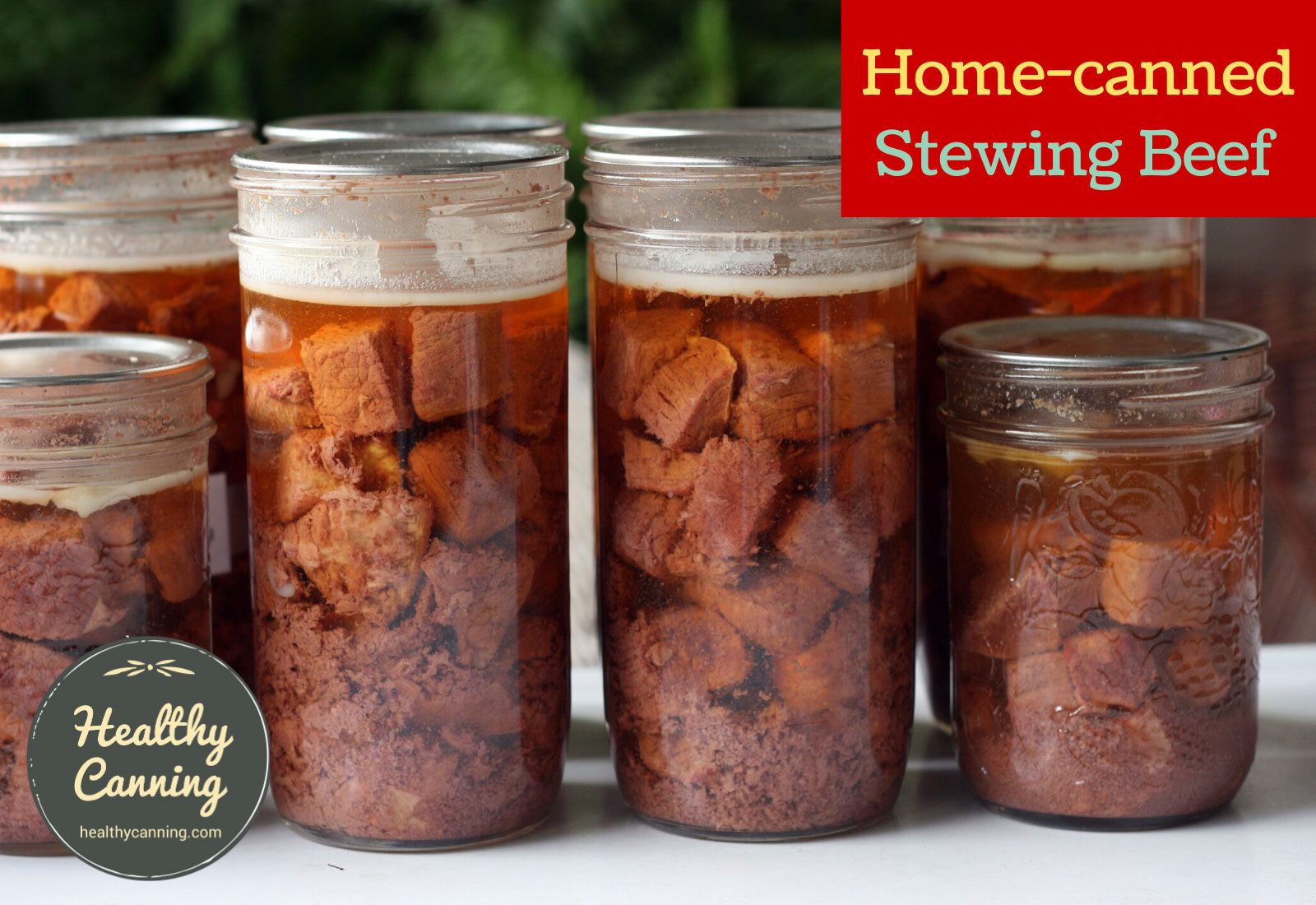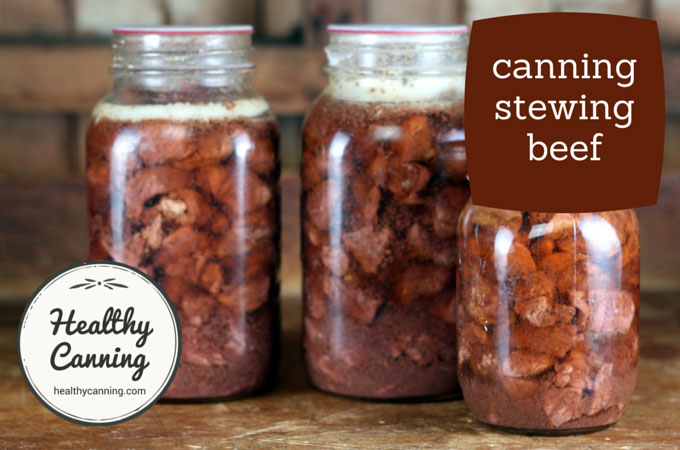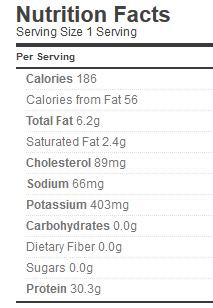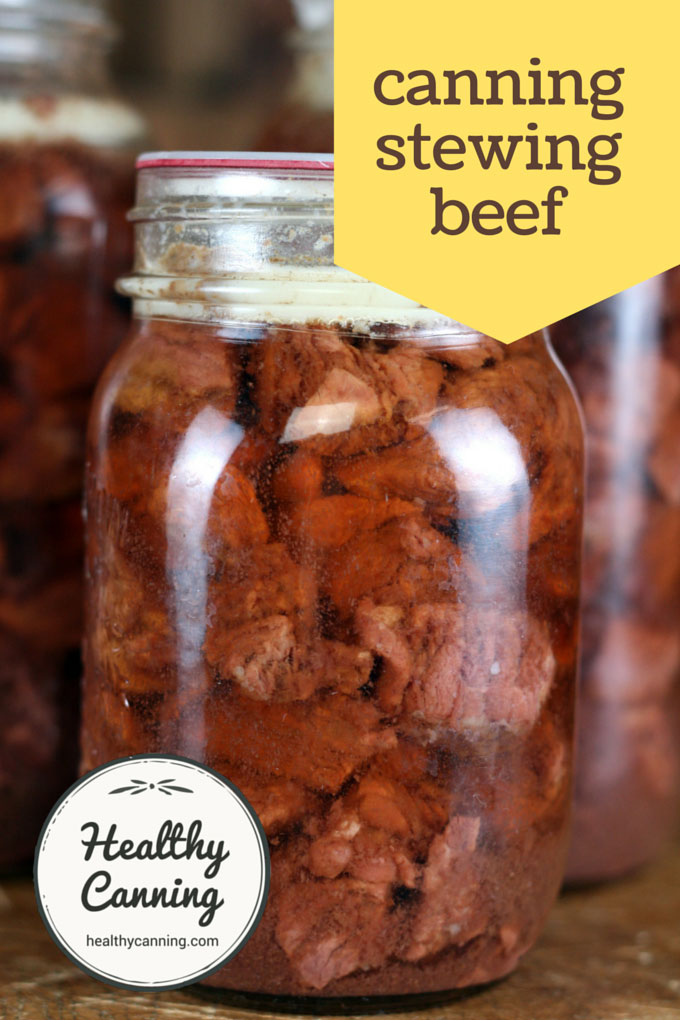How Long Do I Pressure Can Beef Stew
 Even with a pressure cooker, stewing beef can take quite a while to cook properly. When you have jars of home-canned stewing beef on the shelf, then it becomes a fast food ready to use even on a rushed mid-week night.
Even with a pressure cooker, stewing beef can take quite a while to cook properly. When you have jars of home-canned stewing beef on the shelf, then it becomes a fast food ready to use even on a rushed mid-week night.
The pressure canning process gives it a melt-in-your-mouth texture, and a deep beefy flavour that rivals the most skillful braising.
When opening the jar, don't waste the broth that is in the jar, it's pure gold: freeze it for use in soups, stews, risottos, gravies, etc.
- 1 Quantities of stewing beef needed
- 2 The recipe
- 3 Pressure canning stewing beef
- 3.1 Ingredients
- 3.2 Instructions
- 4 Reference information
- 5 Recipe notes
- 6 The canning broth
- 7 How large should the cubes of meat be?
- 8 How much fat to use while browning the meat?
- 9 Recipe source
- 10 Nutrition
Quantities of stewing beef needed
On average, as a very rough guideline, expect to need about 500 g (1 lb) of stewing beef per ½ litre (US pint) jar of canned stewing beef.
The recipe
Jar size choices: Either half-litre (1 US pint) OR 1 litre (1 US quart)
Processing method: Pressure canning only
Yield: varies
Headspace: 3 cm (1 inch)
Processing pressure: 10 lbs (69 kPa) weighted gauge, 11 lbs (76 kpa) dial gauge (adjust pressure for your altitude when over 300 metres / 1000 feet)
Processing time: Half-litres (pints) 75 minutes; litres (quarts) 90 minutes

Pressure canning stewing beef
How to home pressure can stewing beef, following tested USDA methods
Prep Time 1 hour
Cook Time 1 hour 30 minutes
Total Time 2 hours 30 minutes
Yield 1 varies
Calories 186 kcal
- stewing beef
- water
- pickling salt
-
Trim off any gristle.
-
Cut meat into cubes or strips, if it isn't already.
-
Spray a skillet with cooking spray or heat a small amount of fat or oil in it.
-
Brown meat in the skillet in batches; transfer browned meat to a covered bowl or pot to keep hot.
-
Pack meat into half-litre (1 US pint) OR 1 litre (1 US quart) jars.
-
[Optional]: add ½ teaspoon pickling salt to half-litre (1 US pint) jars; 1 teaspoon of pickling salt to 1 litre (1 US quart) jars.
-
Leave 3 cm (1 inch) headspace.
-
Top jars up with a boiling liquid (water from a kettle, meat, stock, or tomato juice) maintaining 3 cm (1 inch) headspace.
-
Debubble; adjust headspace.
-
Wipe jar rims.
-
Put lids on.
-
Processing pressure: 10 lbs (69 kPa) weighted gauge, 11 lbs (76 kpa) dial gauge (adjust pressure for your altitude when over 300 metres / 1000 feet)
-
Processing time: half-litre (US pint) jars for 75 minutes OR 1 litre (US quart) jars for 90 minutes.
Processing guidelines below are for weighted-gauge pressure canners. See also if applicable: Dial-gauge pressures.
| Jar Size | Time | 0 to 300 m (0 - 1000 feet) pressure | Above 300 m (1000 ft) pressure | |
|---|---|---|---|---|
| ½ litre (1 US pint) | 75 mins | 10 lbs | 15 lb | |
| 1 litre (1 US quart) | 90 mins | 10 lbs | 15 lb |

Reference information
How to pressure can.
When pressure canning, you must adjust the pressure for your altitude.
More information on canning meat.
Shelf life for home-canned goods
Recipe notes
- Instead of the salt, you can use a non-bitter, non-clouding salt sub. We have found Herbamare Sodium-Free performs well in that regard.
- Ball / Bernardin Complete Book (2015, page 396) suggests that if you have a lot of meat to brown, spread it out in roasting pans / trays and sear in a hot oven until brown on the outside but still rare on the inside.
The canning broth
The USDA Complete Guide (2015) advises to fill with a boiling liquid (water from a kettle, meat, stock, or tomato juice). In their advice the liquid is meant to be unthickened.
The Ball / Bernardin Complete Book (2015) allows the canning broth for cubes or strips of meat to be slightly thickened with Clearjel. "If desired, ClearJel can be used to lightly thicken the broth in this recipe." [1] Kingry, Judi and Lauren Devine. Ball / Bernardin Complete Book of Home Preserving. Toronto: Robert Rose. 2015. Page 397. They do not state what "lightly" means.
How large should the cubes of meat be?
Bernardin Guide says, " ½ to 1 inch (2 to 3 cm) pieces" (Bernardin Guide 2103. page 100).
Ball / Bernardin Complete Book says, "… cut with the grain into jar-size pieces or cubes suitable for cooking and canning." (2015, page 396.)
How much fat to use while browning the meat?
When canning meat, you don't want too much fat involved, because it can interfere with the seal of the jar, and go rancid in storage.
You have to use your own judgement, as you don't get any precise guidance.
The USDA Complete 2022 instructions say, "Precook meat until rare by roasting, stewing, or browning in a small amount of fat." (Page 5-6).
The Ball / Bernardin Complete Book says, ".. brown it in a skillet, over medium heat, using no more than 1 tbsp of added fat or vegetable oil." (2015, page 396.)
The Ball / Bernardin advice isn't much more help, because they don't say per what quantity of meat the fat applies to.
Recipe source
This recipe comes from the USDA Complete Guide.
- Strips, Cubes or Chunks of Meat. In: United States Department of Agriculture (USDA). Complete guide to home canning. Agriculture information bulletin No. 539. 2015. Page 5- 6.
Note, the USDA also gives a raw-pack option.
Nutrition
Serving size: 100 g (3.5 oz / ⅕th of a ½ litre / US pint jar)
Per 100 g:
- 186 calories, 66 mg sodium.
- Weight Watchers PointsPlus®: 3 points

* Nutrition info provided by https://caloriecount.about.com
* PointsPlus™ calculated by healthycanning.com. Not endorsed by Weight Watchers® International, Inc, which is the owner of the PointsPlus® registered trademark.

Source: https://www.healthycanning.com/canning-stewing-beef
0 Response to "How Long Do I Pressure Can Beef Stew"
Post a Comment